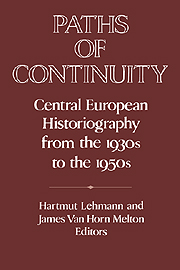Book contents
- Frontmatter
- Introduction: Continuities in German Historical Scholarship, 1933-1960
- 1 German Historiography from the 1930s to the 1950s
- 2 Friedrich Meinecke (1862-1954)
- 3 Change and Continuity in German Historiography from 1933 into the Early 1950s: Gerhard Ritter (1888-1967)
- 4 Hans Rothfels (1891-1976)
- 5 Franz Schnabel (1887-1966)
- 6 Heinrich Ritter von Srbik (1878-1951)
- 7 “Historical Social Science” and Political Myth: Hans Freyer (1887-1969) and the Genealogy of Social History in West Germany
- 8 Some Observations on the Work of Hermann Aubin (1885-1969)
- 9 From Folk History to Structural History: Otto Brunner (1898-1982) and the Radical-Conservative Roots of German Social History
- 10 Werner Conze (1910-1986): The Measure of History and the Historian's Measures
- 11 Continuity, Innovation, and Self-Reflection in Late Historicism: Theodor Schieder (1908-1984)
- Index
7 - “Historical Social Science” and Political Myth: Hans Freyer (1887-1969) and the Genealogy of Social History in West Germany
Published online by Cambridge University Press: 05 January 2013
- Frontmatter
- Introduction: Continuities in German Historical Scholarship, 1933-1960
- 1 German Historiography from the 1930s to the 1950s
- 2 Friedrich Meinecke (1862-1954)
- 3 Change and Continuity in German Historiography from 1933 into the Early 1950s: Gerhard Ritter (1888-1967)
- 4 Hans Rothfels (1891-1976)
- 5 Franz Schnabel (1887-1966)
- 6 Heinrich Ritter von Srbik (1878-1951)
- 7 “Historical Social Science” and Political Myth: Hans Freyer (1887-1969) and the Genealogy of Social History in West Germany
- 8 Some Observations on the Work of Hermann Aubin (1885-1969)
- 9 From Folk History to Structural History: Otto Brunner (1898-1982) and the Radical-Conservative Roots of German Social History
- 10 Werner Conze (1910-1986): The Measure of History and the Historian's Measures
- 11 Continuity, Innovation, and Self-Reflection in Late Historicism: Theodor Schieder (1908-1984)
- Index
Summary
Let us begin with a few representative quotations.
As is by now well known, it took the famous Fischer Controversy of the 1960s together with the general intellectual radicalism of that time and the loosening of the ideological climate to assemble the conditions for an ambitious and extensive social history in the Federal Republic. . .
;Under the umbrella of “history as a critical social science” (“Geschichte als kritische Sozialwissenschaft”) there assembled rather diverse groups of historians, united only in one respect, namely their willingness to transgress the narrow confines of political history understood as the interaction of states and statesmen. . . . In the 1970's by the foundation of a new journal “Geschichte und Gesellschaft” social history established itself as a discipline which sought the cooperation of the social sciences, defining its methods by reference to Max Weber and empirical social research rather than by traditional historical thought.
In my view, social history should in no way be equated with the ominous “structural history.” “Structural history” was a slogan of the 1950s, connected above all with the name of Werner Conze. . . which was based on a misunderstanding of the concept of structure developed in the discussion between French historians and stucturalists. . . . The global problem of social structure can only be tackled by way of the various academic disciplines. The first realm which comes to mind is that of historical demography, which had its breakthrough in France during the 1950s, then was taken up by the British. . . . In the Federal Republic, there are at present few scholars doing this type of research.
- Type
- Chapter
- Information
- Paths of ContinuityCentral European Historiography from the 1930s to the 1950s, pp. 197 - 238Publisher: Cambridge University PressPrint publication year: 1994
- 1
- Cited by



